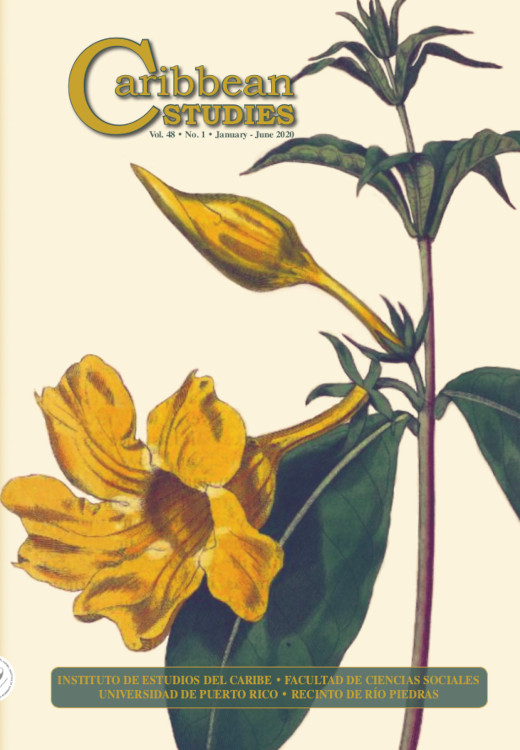Abstract
Outcrop sequences reported in the literature as Aptian–Albian were studied using foraminifera and calcareous nannofossils. The use of two fossils groups minimize the uncertainly for correlation with the world stratigraphic cycles. For this sequences located at Pico García, La Paloma Hill and Grande–Los Hoyos Hill (Monagas, Serranía del Interior) and Borracha and Chimana Islands (Anzoátegui) 152 samples were collected in the more shale sediments. The result shows that bed rocks from Barremian(?)–early Aptian (KS6 foraminiferal zone) outcrop in Pico García and Borracha island. The presence of the Schackoina cabri zone is confirmed, foraminiferal zone KS7, with 3 meter thick and age between 125.5 to 124 Ma, with possible presence in Chimana Island. The lack of planktonic markers between late Aptian and middle Albian force to use large foraminifera (dominated
by Orbitolina texana) which have a long life span. The look for other sections with deeper sediments for refining this age interval is suggested by our results. Late Albian is characterized by the presence of Eiffelithus turriseiffelli and Ticinella primula, at the base of Querecual Formation highlight an 103.13 Ma age for Borracha Island meanwhile at Grande–Los Hoyos Hill (Serranía del Interior), the presence of Rotalipora appenninica and Ticinella primula at the base of the same formation gives an 101.92 Ma age.
References
Armstrong, H.A. y M.D. Brasier. 2005. Microfossils. Segunda edición. Oxford: Blackwell Publishing.
Arnaud-Vanneau, H., et al. 2000. “Le Crétacé inférieur de Venezuela oriental: stratigraphie séquentielle des carbonates sur la transversal Casanay-Maturin (Etats de Anzoátegui, Monagas et Sucre)”. Geologie Alpine 76:3-81.
Arnaud-Vanneau, A., et al. 1987. “The lower Cretaceous from The Jura Platform to the Vocotian Basin (Swiss Jura, France)”. Third International Cretaceous Symposium, pp. 1-33.
Behrensmeyer, A.K. y A. Turner. 2013. Taxonomic ocurrences of Suidae recorded in the Paleobiology Database, Fossilsworks. <http://fossilworks.org/> Consulta febrero 2016.
Bolli, H.M., J.P. Beckmann y J.B. Saunders. 1994. Benthic Foraminiferal Biostratigraphy of the South Caribbean Region. Cambridge: Cambridge University Press.
BouDagher-Fadel, M.K., 2008. Evolution and Geological Significance of Larger Benthic Foraminíferos. Developments in Paleontology and Stratigraphy 21. Ámsterdam: Elsevier.
Caron, M. 1985. “Cretaceous Planktic Foraminifera”, en H.M. Bolli, J.B. Saunders y K. Perch-Nielsen, eds. Plankton Stratigraphy. Vol. 1. Cambridge: Cambrigde University Press, 17-86.
Crux, J. 1994. Cretaceous nanofossils. Curso PDVSA Intevep.
Dager, R. 1990. “Zur Palaogeographie und Biologie von Weischselia reticulate im Hauterive-Barreme (Underkreide)”. Feddes Repertorium 101(5-6):319-331.
Di Gianni-Canudas, N. 1989. Curso de nannofósiles. Corpoven S.A. Gerencia de Geología. Laboratorio geológico, 1-15.
Diéguez, C. y N. Meléndez. 2000. “Early Cretaceous ferns from lacustrine limestones at Las Hoyas, Cuenca Province Spain”. Paleontology 43(6):1113-1141.
El-Khayal, A.A. 1985. “Wealden fern Weichselia reticulate in Saudi Arabia”. Scripta Geol. 79:75-88.
Falcón, R. 1989a. “Estudio bioestratigráfico preliminar mediante foraminíferos en el Miembro García de la Formación El Cantil. Cretácico inferior de Venezuela oriental”. Memorias 50mo Aniversario de la Escuela de Geología Minas y Geofísica. Facultad de Ingeniería, Universidad Central de Venezuela, 36-47.
Falcón, R. 1989b. “Revisión y redefinición del término ‘Miembro García’ como Formación García. Cretácico inferior de Venezuela oriental”. Memorias 162 Humberto Carvajal Chitty, Olga Rey 50mo Aniversario de la Escuela de Geología Minas y Geofísica. Facultad de Ingeniería, Universidad central de Venezuela, 48-58.
Föllmi, K. 2012. “Early cretaceous life, climate and anoxia”. Cretaceous Research 35:230-257.
González de Juana, C., J.M. Iturralde de Arozena y X. Picard Cadillat. 1980.
Geología de Venezuela y sus cuencas petroleras. Tomo I. Caracas: Ediciones Foninves.
Gradstein, F., J.G. Ogg, M.D. Schmitz y G.M. Ogg, eds. 2012. The Geologic Time Scale 2012. Volumen 1 y 2. Oxford: Elsevier.
Guillaume, H.A., H.M. Bolli y J.P. Beckmann. 1972. “Estratigrafía del Cretácico inferior en la Serranía del Interior, Oriente de Venezuela”. Memoria IV Congreso Geológico Venezolano. Boletín de Geología, Edición especial No 5. Tomo III. Caracas: Ministerio de Minas e Hidrocarburos, 1619-1655.
Kaminski, M.A., S. Geroch y D. Kaminski. 1993. The Origins of Applied Micropaleontology: The School of Josef Grzybowski. Oxford: Alden Press/Grzybowski Foundation.
Maples, C.G. y R.R. West. 1991. “Dependent and independent data in paleontology: Tools for the sedimentary modeler”, en E.K. Franseen, et al., eds.
Sedimentary Modeling: Computer simulations and methods for improved parameter definition, Kansas Geological Survey Bulletin 233:177-184.
Martini, E. 1971. Standart Tertiary and Quaternary Calcareus Nannoplankton
Zonation. Hamburgo: Geologisch-Paläontologisches Institut der Universität, 739-785.
Ministerio de Energía y Minas. 1997. Léxico Estratigráfico de Venezuela. Tercera Edición. Boletín de Geología, Edición especial No
. 12. Tomos I y II, Caracas: Ministerio de Minas e Hidrocarburos, 828.
Nejad Shirazi, M.P. y F. Abedi. 2012. “Microbiostratigraphy of The Early Cretaceous Sequence in Northeast of Shiraz, Zagros Basin, Southwest Iran”. Journal of American Science 8(3):54-57.
Odehnal, M. y R. Falcón. 1989. “La zona de Schackoina cabri en Venezuela”.
Memoria VII Congreso Geológico Venezolano 2, Barquisimeto, 524-549.
Payne, S.N.J., D.F. Ewen y M.J. Bowman. 1999. “The role and value of ‘highimpact biostratigraphy’ in reservoir appraisal and development”, en R.W.
Jones y M.D. Simmons, eds. Biostratigraphy in Production and Development Geology. Londres: Geological Society of London Special Publication, 5-22.
Perch-Nielsen, K. 1985. “Mesozoic Calcareus Nannoplankton”, en H.M. Bolli, J.B. Saunders y K. Perch-Nielsen, eds. Plankton Stratigraphy. Vol. 1. Cambridge: Cambridge University Press, 329-426.
Rod, E. y W. Maync. 1954. Revision of Lower Cretaceous stratigraphy of Venezuela, AAPG Bulletin 38(2):193-283. Doi: <https://doi.org/10.1306/5CEADECC16BB-11D7-8645000102C1865D>.
Sliter, W.V. 1989. “Biostratigraphic zonation for cretaceous planktonic foraminifers examined in thin section”. Journal of Foraminiferal Research 19(1):1-19. Aportes a la bioestratigrafía del Aptiense–Albiense... 163
———. 1996. “Cretaceous planktics foraminifers examined in thin section”.
Curso PDVSA. Puerto La Cruz, enero 22-26.
Thierstein, H.R. 1976. “Mesozoic Calcareus Nannoplankton biostratigraphy of
marine sediments”. Marine Micropaleontology 1:325-362.
Vivas, V y O. Macsotay. 1995. “Dominios tectono-estratigráficos del CretácicoNeógeno en Venezuela nor-oriental”. IX Congreso Latinoamericano de Geología. Caracas, noviembre 5-8.
Vivas, V. 1987. “Bioestratigrafía del Cretáceo de la región de Bergantín Santa Inés, estado Anzoátegui, Venezuela nororiental”. Boletín de Geología XVI (29):1-128

